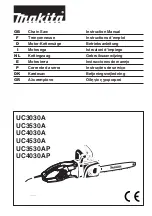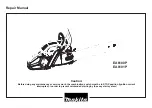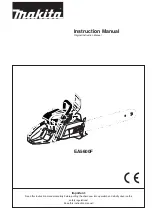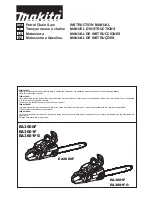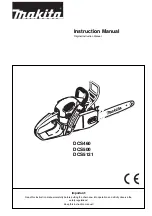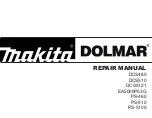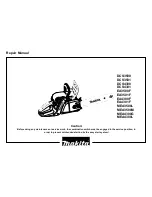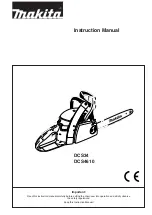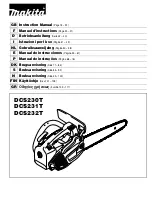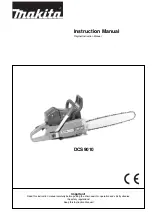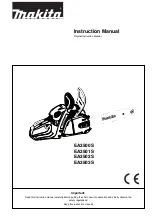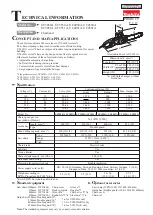
POWXQG4070
EN
Copyright © 2014 VARO
P a g e
|
8
www.varo.com
7.3.4
To adjust saw chain:
Hold nose of guide bar up and turn adjustment screw (16) clockwise to increase chain
tension. Turning screw counterclockwise will decrease amount of tension on chain. Ensure
the chain fits snugly all the way around the guide bar. (fig 5)
After making adjustment, and while still holding nose of bar in the uppermost position,
tighten the bar retaining nuts securely. Chain has proper tension when it has a snug fit all
around and can be pulled around by gloved hand.
Note: if chain is difficult to rotate on guide bar or if it binds, too much
tension has been applied. This requires minor adjustment as follows:
Loosen the bar retaining nuts so they are finger tight. Decrease tension by turning the bar
adjustment screw counterclockwise slowly. Move chain back and forth on bar. Continue to
adjust until chain rotates freely, but fits snugly. Increase tension by turning bar adjustment
screw clockwise.
When saw chain has proper tension, hold nose of bar in the uppermost position and
tighten the 2 bar retaining nuts securely.
Caution: a new saw chain stretches, requiring adjustment after as few as 5
cuts. This is normal with a new chain, and the interval between future
adjustments will lengthen quickly.
Caution: if saw chain is too loose or too tight, the sprocket, bar, chain, and
crankshaft bearings will wear more rapidly. Study fig.6 for information
concerning correct cold tension (A), correct warm tension (B), and as a
guide for when saw chain needs adjustment (C).
7.3.5
Chain brake mechanical test
Your chain saw is equipped with a chain brake that reduces possibility of injury due to
kickback. The brake is activated if pressure is applied against brake lever when, as in the
event of kickback, operator
’s hand strikes the lever. When the brake is actuated, chain
movement stops abruptly.
Warning: the purpose of the chain brake is to reduce the possibility of
injury due to kickback; however, it cannot provide the intended measure of
protection if the saw is operated carelessly. Always test the chain brake
before using your saw and periodically while on the job.
7.3.6
To test chain brake:
The chain brake is disengaged (chain can move) when brake lever is pulled back and
locked. Be sure the chain brake latch is in the off position. (fig. 7a)
The chain brake is engaged (chain is stopped) when brake lever is in forward position and
the chain brake latch is in the on position. You should not be able to move chain. (fig. 7b)
Note: the brake lever should snap into both positions. If strong resistance
is felt, or lever does not move into either position, do not use your saw.
Take it immediately to a professional service center for repair.
Don’t let your motor run in high speed when your chainbrake is activated.





















